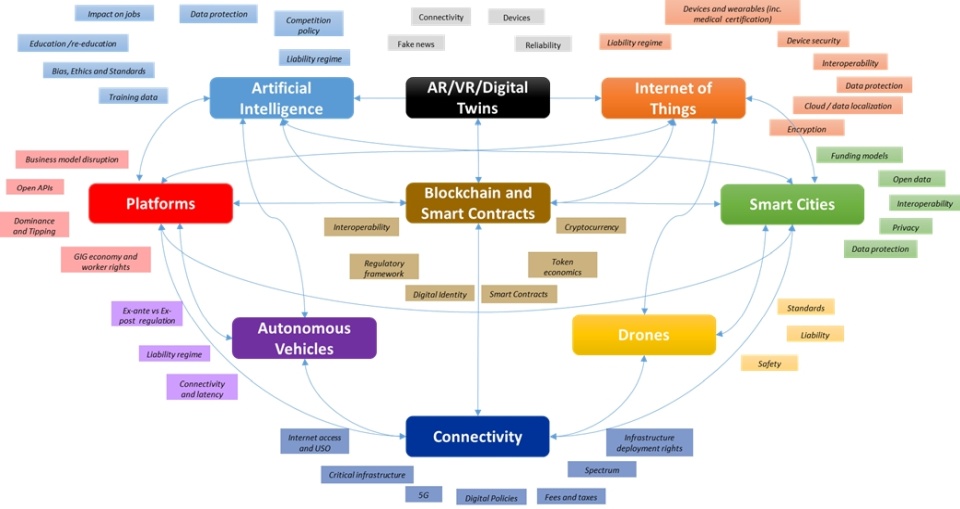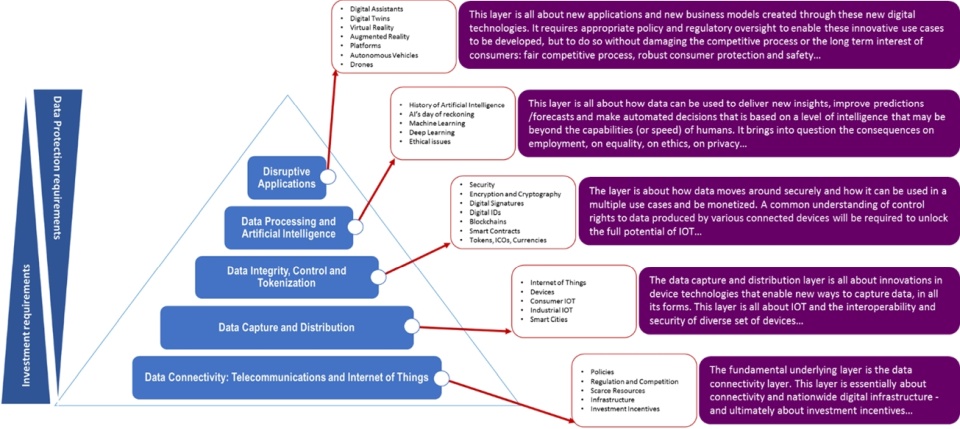Industry Thought Leadership
Digital Disruption
June, 2021The digital revolution that we see evolve in front of our eyes, has applications and systems that are collecting, distributing and making available massive amounts of data to almost any situation, which can be reproduced infinitely at virtually zero cost and used for significant productivity gains. The impact of this digital revolution will have on society and economies is likely to be as dramatic, if not bigger than the previous industrial revolutions. The World Economic Forum estimates point to more than US$10 trillion of value from digitization in five key global industries over the next decade.1 In 2018, McKinsey Global Institute, estimated that an additional $13 trillion could be added to global GDP by 2030 through digitization, automation, and Artificial Intelligence (AI).2
What’s new?
Digitization of businesses is not new, although it is taking on a new dimension as we see the convergence of emerging technologies and innovative business and operating models emerge. Whilst there has been much change and in a short period of time, this is only the beginning. This so-called fourth machine age is just emerging with further advances in digital technologies/computing and, more importantly, their convergence, driven by Internet of Things (IOT), Artificial Intelligence (AI), and high-speed ubiquitous connectivity (5G). It would be wrong to assume that this new revolution is only driven by data. Whilst data is a fundamental enabler for this fourth revolution, it is disruption through engineering and physics such as miniaturization, nanotechnologies, energy storage, etc., which cannot be overlooked. The most significant advancements are happening where these two disruptive forces intersect. Whilst each of these emerging technologies are being developed independently and used for different purposes, the fundamental question is how these technologies are interconnected and what disruptive impact they can have on business and operating models. Figure 1 shows the interconnectedness of some of these key emerging technologies.

Figure 1: Interconnectedness of emerging technologies
To make sense of this order of complexity, we need a simple framework to understand how these technologies relate to each other and what impact they might have not only individually but also collectively. Such a framework needs to start from a perspective of how data moves along the value chain from data capture to the applications that make use of data. In the end, digital is after all about the use of data to create value. Figure 2 illustrates a framework I have developed for looking at the data ecosystem and the key technologies that sit at each layer of this ecosystem.
It would be impossible to look at all of these layers and technologies in detail here – something I have done so in my book Digital Disruption.3
Re-defining the business model
Seven out of ten most valuable public companies in the world by market capitalization are digital platforms. These are Apple, Microsoft, Amazon, Alphabet, Facebook, Tencent Holdings and Alibaba Group. So why are digital enabled businesses growing so rapidly and being valued at such rates? Traditional corporate leaders typically face a set of challenges to grow and expand usually as a result of constraints placed by their operating model. Digital businesses dissolve these intrinsic limits of scalability and scope. Their operating models are designed to scale at rates that traditional firms just cannot fathom.

Figure 2: The data ecosystem
In traditional firms, value creation and capture is typically created and captured from the same source, i.e. through sales of goods and services through the price mechanisms. In digital businesses, the sources and options for value creation and capture are broader because value creation and capture can be separated more easily and often come from different stakeholders through modular design.
Many firms are doing digital versus being digital, that is, they use technology to fix isolated problems rather than as part of an overall business strategy. Simply investing in digital technologies to digitalize existing functions and processes is not enough. Digital firms think differently in another critical way. They realize that the concept of the vertically integrated enterprise going it alone is antiquated. In many ways, whilst most firms are not platforms, they need to start thinking like platform players – and move beyond looking at sectors and to the wider ecosystem.
Re-orchestrating the operating model
Operating models deliver the value promised to customers. Ultimately the goal of an operating model is to deliver value at scale, to achieve sufficient scope and to respond to changes. In traditional firms, the intrinsic scalability and economies of scope that could be derived from technology is limited by the operating architecture of the firm that it was deployed in. But digitally enabled firms are designed and architected to release the full potential of digital networks, data algorithms and AI. The more a firm is designed for scale and scope in its operating model, the more value it can create and capture. The problem of increasing complexity is managed through software and analytics, rather than hiring more layers of managers. However, a key challenge in driving digital transformation is that the whole organization is optimized for the current business model. Fundamentally, the organization itself prohibits breakout from the old model. To transform the organization, requires a break out from the old model, old people, old metrics and old investment profiles. Digital transformation is not just about bringing cross-functional teams and IT systems together, but also about bringing cross-functional data together.
Impact on society and policy making
Whilst the adoption of digital technologies has the potential to have profound changes to the competitor landscape and on consumers, it equally has the potential for profound impact on societies and economies, some which we may not necessarily desire. To turn these disruptive technologies into a force for good may require us tearing up existing government policies and regulatory approaches that have served us reasonably well to date. However the very nature of these digital technologies means that jurisdictional national boundaries are dissolving, their reach is global, their adoption pervasive and the way they work not always transparent or predictable.
The rapid scale of change that is enabled by digitization is already impacting large swathes of society. The way people interact with their friends and colleagues, the way people get their news or the way society buys goods and services has profoundly changed in the last decade. As a society we are giving access to our personal data – what we like, who we like, where we go and what watch we watch online - some without us even noticing. The very fabric of trade is changing – sometimes we are not transacting with fiat money but through the intrinsic value of our personal data. The nature of competition is changing primarily through greater automation and new ecosystems. This is already starting to impact employment patterns and the wages people earn.
These are just some of the societal impacts of digitization. This is however just the start – the impact of digitization is going to be much wider and deeper. It will require major policy responses – some of which may need us to have a wholesale rethink about what we value as a society – some of which will need to be coordinated globally.
About the Author:
Dr. Vagadia is Group Head of Regulatory Affairs at Ooredoo Group, Board Director at Ooredoo Myanmar, Chairs the GSMA APAC Policy Group, and is the author of four books, the latest titled Digital Disruption. Prior to joining Ooredoo, he spent 15 years as a management consultant advising governments, regulators, multinationals as well as start-ups in over 20 countries. He holds a PhD, MBA, LLM, B-Eng and has qualifications in marketing and governance from the UK. He is an advisor at HEC Paris in Qatar.
1 World Economic Forum. (2017). Digital transformation initiative telecommunications industry. The five key global industries are: E-commerce (US$3.1 trillion), Automotive (US$2.6 trillion), Logistics (US$2.1 trillion), Electricity (US$1.5 trillion), Media and Entertainment (US$0.7 trillion).
2 Assessing the economic impact of artificial intelligence. ITU Trends. Issue Paper No. 1. September 2018.
3 Digital Disruption: Implications and opportunities for Economies, Society, Policy Makers and Business Leaders. (2020). Vagadia, B. See: https://www.springer.com/gp/book/9783030544935

